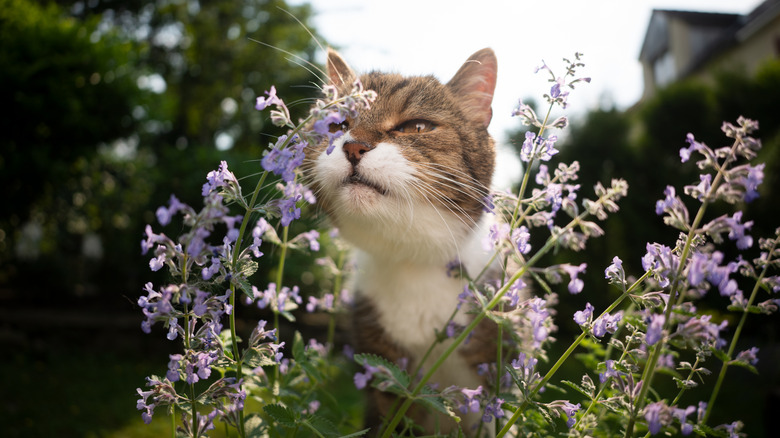Why You Should Reconsider Planting Catnip And What To Plant Instead
Many people plant catnip (Nepeta cataria) in the yard to take their cats on a psychedelic journey or help them cope with anxiety. Others cultivate catnip in the garden to banish flea beetles or make tea from its leaves. Though this plant can be useful, avoiding it is wise because it grows so aggressively. Like some other members of the mint family, it can spread rapidly, which is why it's considered invasive in West Virginia and national parks in the mid-Atlantic United States. If you live near one of these places, don't plant it and remove any you find. Consider replacing it with catmint (Nepeta racemosa, Nepeta nepetella, or Nepeta x faassenii), a related species that's much easier to control.
Though people sometimes refer to catmint as catnip, and vice versa, these plants have some important differences. Like catnip, catmint sports fuzzy, toothed leaves, but they're usually bigger. It tends to grow in contained clumps rather than developing a weedy appearance and taking over your garden. Catmint's flowers are an attractive shade of violet, which many gardeners prefer to catnip's white blooms with purple flecks. Plus, humans like its fresh, minty scent better than catnip's skunk-like odor.
Catmint is easy to grow, even for new gardeners. It can handle drought and less-than-ideal soil, so you can use it to landscape areas that fussier plants won't accept, such as hilly ground and weedy patches near buildings. This plant works especially well as a ground cover, and it's unlikely to get destroyed by deer and rabbits. Place it somewhere with adequate soil drainage and some sun access, and you should be good to go.
How to use catmint in your yard and beyond
Compared to catnip, catmint doesn't produce as much nepetalactone, an oil that has psychoactive properties for cats. In other words, your feline friends may find catmint interesting, but they're not likely to develop an obsession. This plant is likely to attract more bees than neighborhood cats. It's also a big draw for hummingbirds and butterflies. Unlike catnip, catmint blooms throughout the growing season, making it a perfect choice for pollinator gardens. Consider growing it in containers, which lets you move the plant to different parts of your yard you'd like pollinators to visit.
You can also use catmint's leaves for tea and homemade insect repellent. Crush the leaves, apply their liquid to your skin, and watch its soothing scent repel mosquitoes. Or, blend the leaves with water and a few drops of gentle dish soap, then spritz it on your skin or even your plants. Garden invaders like cabbage loopers, squash bugs, and aphids find catmint's scent particularly odious. Planting catmint in different parts of your yard can also discourage insects from bothering you and your vegetable garden. In the rare event that pests such as thrips infest your catmint plants, use neem oil or insecticidal soap to remedy the problem.

